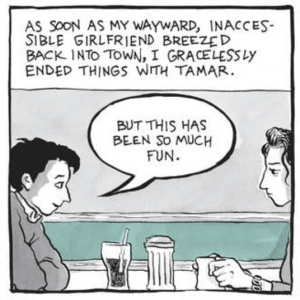Gradual Impact (by Alison Bechdel)


1. what is the conflict?
Although it might at first seem that the conflict is between Tamar and Alison, the story actually focuses on Alison’s inner conflict. Alison struggles to separate the physical aspect and emotional aspect of their relationship. She uses Tamar’s outfits (jewelry, deep neck shirt, skirt) to highlight her beauty and feminity. She says a part of why she broke it off with Tamar was because she was “uncomfortable with her[Tamar’s] beauty. Her flawless skin, along with her calm good humor”.
2. how do the images shape our understanding?
- Colours: The blue monochromatic colors sets a melancholy mood/tone.
- Close-ups: Bechdel usually uses close-ups during sexual scenes to suggest intimacy.
- Facial expressions: she draws very detailed facial expressions as a very literal way to convey emotions
- Angles: Quite a few times, Alison puts us in her perspective by the angles she uses.
3. what, if anything, does Bechdel seem to be saying about the world or life? How is this story about anything more than one time, this happened to her?
Although this was a moment in her life that didn’t really have much impact on her future nor was it a good memory, we are shown in the last few panels that she still reminisces about it. This suggests how every past memory is sweet and hard to let go of; reminiscing has a bittersweet feeling. This is similar to Fun Home, as Alison constantly reminisces about her relationship with her father and bad childhood memories.
4. comparing this to FUN HOME, how might we recognize Bechdel’s voice, style, themes?
- Bechdel has a lot of sexual themes in her work, and this is no exception.
- She uses emotive language to convey those themes
- Bechdel has text at the top of each panel, which are Alison’s present thoughts on her past experiences
- She uses academic writing
- She always alludes to other pieces of literature to convey her thoughts. Here she mentions a play, “my dinner with Andre”, to show the parting of her and Tamar.
- Like Fun Home, Alison is looking back on her past self, creating a reminiscent, bittersweet tone
Fragment 19 (Sappho)


1. Which translation of the long fragment do you prefer: Anne Carson’s (on the left) or Julia Dubnoff’s (on the right)? Why?
I prefer Anne Carsons. Donbroff takes the more literal approach whereas Carson uses more emotive language to convey passionate, sexual love. I also prefer the structure in Carson’s. The lines are much shorter which leaves more silence between the words. It creates a visual of Sappho reminiscing on these memories, picking bits and pieces to share. I also like that Carson acknowledges the missing parts by placing brackets in their place. It especially adds a very melancholy and wistful tone to the last stanza. Although not intentional, the missing lines in the last stanza almost create a visual of Sappho finally realizing the finality of the situation. Too pained to speak about this person anymore, and losing the words to say. These things make Carson’s translation seem more raw and honest.
2. What poetic techniques characterize Sappho’s voice / Considering all the fragments together, how might you describe Sappho’s voice?
- Sexual
- Use of imagery
- “and many woven garlands made of flowers around your soft throat”
- Writes in the first person
- Writes in stanzas (around 3 lines per stanza)
- Emotive language
- Passionate, melancholy, wistful tone
- Assonance
- “on soft beds you satisfied my passion” (sibilance)
3. Is there a consistent persona? (do you know the difference between a persona and a character?)
A persona is a specific part of an individual’s personality that they project to the readers, whereas a character shows all the different personalities and sides of the individual. There is a consistent persona: Someone who wistfully longs for sexual, passionate love.
4. What does Sappho’s work imply about life and the world? What are the values she has made implicit in her work? What does she suggest is true about the world? Is her poetry a celebration of life a cry of pain, or both? Explain.
Both. Sappho uses emotive language to suggest a passionate and sexual relationship, as well as themes of holiness which might represent how sacred the relationship was to her. It’s like a celebration of their relationship. However, as mentioned before, the last stanza has a very melancholy and wistful tone. It shows the pain and sadness that comes with the end of a relationship. Thus, this fragment shows the bittersweet feeling of reminiscing the loss of someone you care about.
5. Is there tension in the poems? Between what forces or elements?
The tension between moving on but also not forgetting what you learned from the relationship and appreciating the experience.
Both
Ø To what extent are both poems “apostrophes”? (according to The Poetry Foundation, an apostrophe is “an address to a dead or absent person, or personification as if he or she were present.”)
Both pieces are memories of past relationships with past lovers. Both of their lovers are absent and thus can’t actually respond, and they both talk about their lover in the second person. (https://www.litcharts.com/literary-devices-and-terms/apostrophe)
Ø What lines or situations in one echo the other?


Ø How do they approach the same subject differently?
Both reminisce on a past relationship.
- Sappho reminisces on the good times, using emotive language to show how passionate and real the love they had was.
- Bechdel reminisces on the bad times and uses humor to maybe cope with the pain

